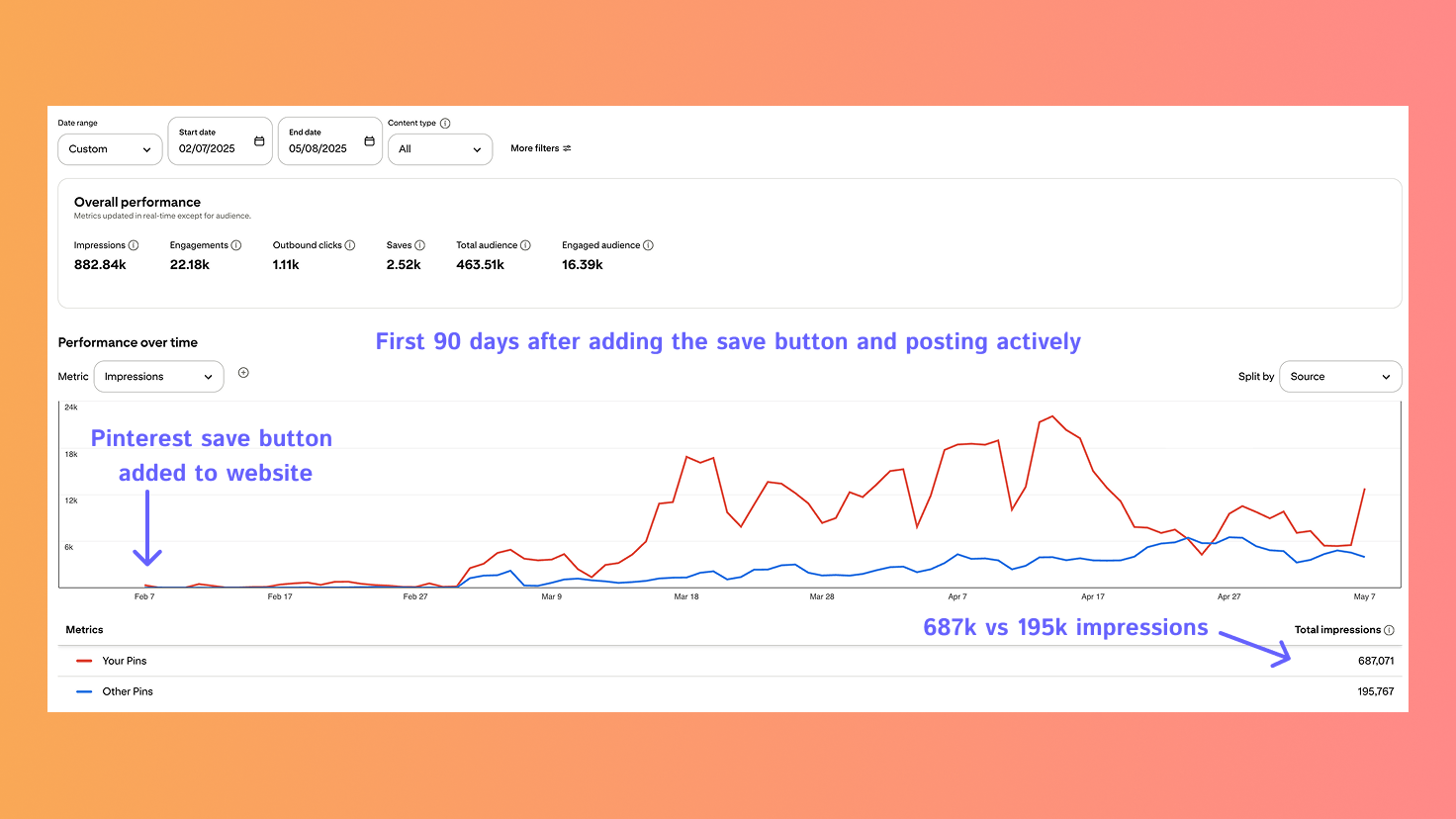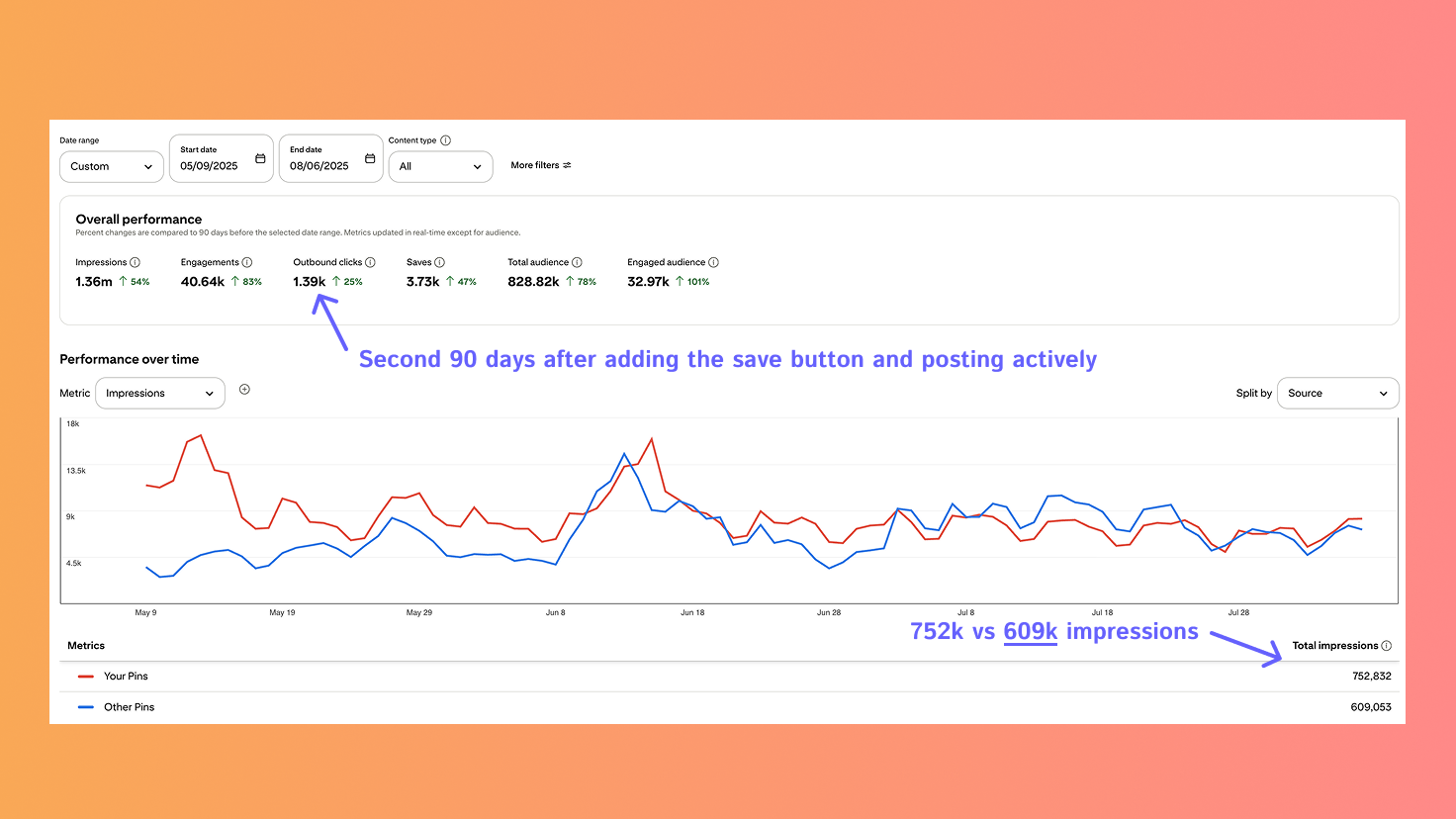What if I told you that a 5-minute website change could generate 800k+ impressions and 22k+ engagements in 6 months—completely passively? Here's the exact strategy that made it happen.
A Simple Change That Drove Passive Growth
In February 2025, after getting frustrated with the manual pinning process, I asked myself: what if I made it easy for visitors to pin my content instead? That's when I made one small but powerful change to my website — I added Pinterest save buttons to every image. Not just the usual "share this post" buttons, but image-specific ones that appear when someone hovers over a picture.
The goal? A better user experience if visitors want to pin my content and an opportunity to experiment what this will bring.
Six months later, the results exceeded expectations: over 804k impressions came from other people sharing my content for me.
Months 1–3: Early Signs of Growth

The first three months showed steady but modest traction:
- Pinterest sharing started almost immediately after implementation
- Impressions grew from nearly zero to consistent daily passive traffic
- Other people began organically pinning my content (blue line), not just my own activity (red line)
- Clear proof the buttons were being used without any prompting
I expected some results from my own Pinterest activity, but seeing visitors save and share my content organically was the real win. My audience was doing the marketing work for me.
Months 4–6: The Compound Effect

This is where it got interesting. Compared to the first three months:
- 54% increase in impressions
- 83% increase in engagements
- 25% increase in outbound clicks
- 752k impressions from my pins vs. 609k impressions from others pinning my content
By the second quarter, organic impressions from other people's pins nearly matched the results from my own activity.
The "Set It and Forget It" Results
Here's what happened when I let my visitors do the marketing:
- 800k+ passive impressions from others pinning my content
- 22k+ engagements
- 744 outbound clicks
- Zero ongoing effort required
And all of this came from one change: adding Pinterest save buttons to every image.
The biggest surprise? The organic amplification. I thought I'd need to stay highly active on Pinterest. Instead, making my images easy to pin let visitors do the sharing for me.
Why This Strategy Works So Well
This isn't just about Pinterest—it's about creating a self-sustaining traffic system. Every visitor becomes a potential multiplier of your reach. While other traffic sources require constant feeding (SEO updates, social posts, paid ads), Pinterest sharing creates compound growth that works while you sleep.
Think about it:
- Your content works 24/7 without ongoing effort
- Each pin can be discovered months or years later through Pinterest search
- Your audience grows exponentially as their networks discover your content
- Traffic quality stays high because people are actively choosing to engage
- Results compound over time instead of decaying like most social media
The Implementation Challenge
If you publish visual content—blog posts with images, product shots, infographics, tutorials—Pinterest's 500M+ monthly active users 1 could become your distribution partners. The setup is straightforward, but there are some technical considerations around button placement, mobile experience, and tracking.
Key insights from this experiment:
- Traffic compounds over time instead of fading out quickly
- Your audience expands beyond your direct visitors automatically
- Pins act as distribution—others spread your content for you
- Results last longer than typical social media posts
- Setup is one-time, benefits are ongoing
The Analytics Gap (And Why It Matters)
Here's the challenge: despite these compelling results, I have limited visibility into which content performs best. Pinterest analytics show overall impressions and clicks, but not URL- or image-level insights. I can't answer questions like:
- Which images are getting saved the most?
- Which types of content (tutorials, product photos, etc.) drive the best results?
- What's the difference between high-performing images and those that get ignored?
I can see Pinterest sharing works, but not why it works or how to optimize it further.
What This Means for Your Content Strategy
This experiment convinced me Pinterest can deliver sustainable, passive traffic that grows over time. The data shows clear compound effects, but also reveals gaps in understanding what drives the best performance.
If 804k passive impressions came from one simple change, optimizing based on proper image-level analytics could potentially multiply these results even further.
The question becomes: how do you identify which visual content resonates most with your audience on Pinterest, and how do you systematically create more of what works?
Have you tried Pinterest sharing for your content? What results have you seen, and do you have visibility into which images actually drive engagement? I'm curious about others' experiences with this strategy.